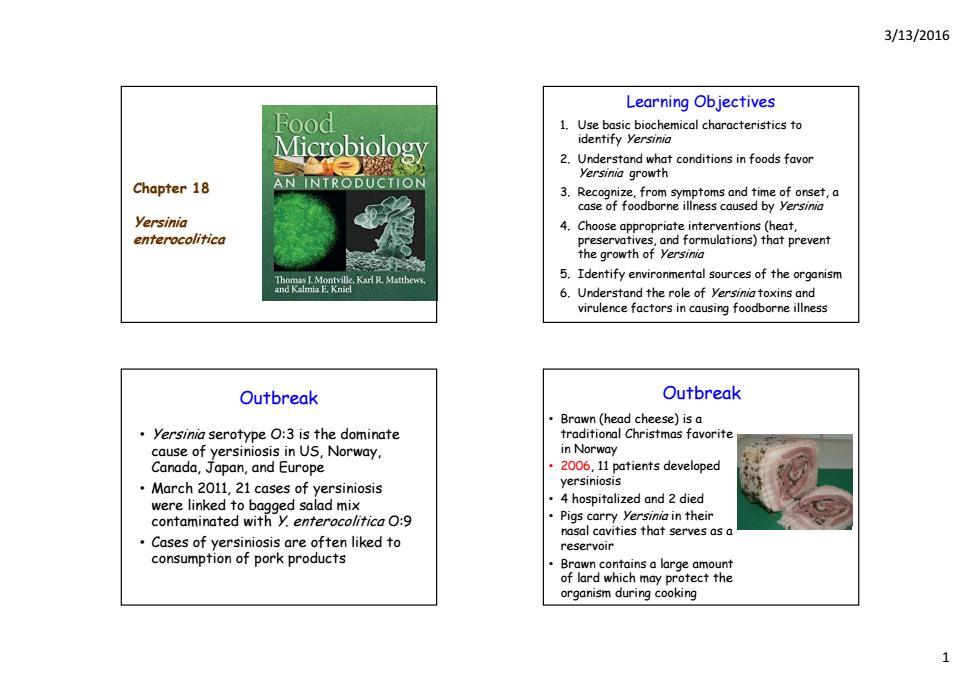
3/13/2016 Learning Objectives Food 1.Use basic biochemical characteristics to identify yersinia 2.Understand what conditions in foods favor Yersinia growth Chapter 18 AN INTRODUCTION 3.Recognize,from symptoms and time of onset,a case of foodborne illness caused by yersinia Yersinia 4.Choose appropriate interventions(heat, enterocolitica her)thatpreven 5.Identify environmental sources of the organism 6.Understand the role of yersinia toxins and virulence factors in causing foodborne illness Outbreak Outbreak Brawn (head cheese)is a Yersinia serotype O:3 is the dominate traditional Christmas favorite cause of yersiniosis in US,Norway. in Norway Canada,Japan,and Europe 2006,11 patients developed March 2011,21 cases of yersiniosis yersiniosis were linked to bagged salad mix .4 hospitalized and 2 died contaminated with y.enterocolitica O:9 Pigs carry yersinia in their nasal cavities that serves as a Cases of yersiniosis are often liked to reservoir consumption of pork products Brawn contains a large amount of lard which may protect the organism during cooking
3/13/2016 1 Chapter 18 Yersinia enterocol enterocol t ca i i Learning Objectives 1. Use basic biochemical characteristics to identify Yersinia 2. Understand what conditions in foods favor Yersinia growth 3. Recognize, from symptoms and time of onset, a case of foodborne illness caused by Yersinia 4. Choose appropriate interventions (heat, preservatives, and formulations) that prevent the growth of Yersinia 5. Identify environmental sources of the organism 6. Understand the role of Yersinia toxins and virulence factors in causing foodborne illness Outbreak • Yersinia serotype O:3 is the dominate cause f i i i i US N of yersiniosis in US, Norway, Canada, Japan, and Europe • March 2011, 21 cases of yersiniosis were linked to bagged salad mix contam nated w th inated with Y. enterocol Y. enterocol t ca i i O 9: • Cases of yersiniosis are often liked to consumption of pork products Outbreak • Brawn (head cheese) is a traditional Christmas favorite in Norway • 2006, 11 patients developed yersiniosis • 4 hospitalized and 2 died • Pigs carry Yersinia in their nasal i i h l cavities that serves as a reservoir • Brawn contains a large amount of lard which may protect the organism during cooking
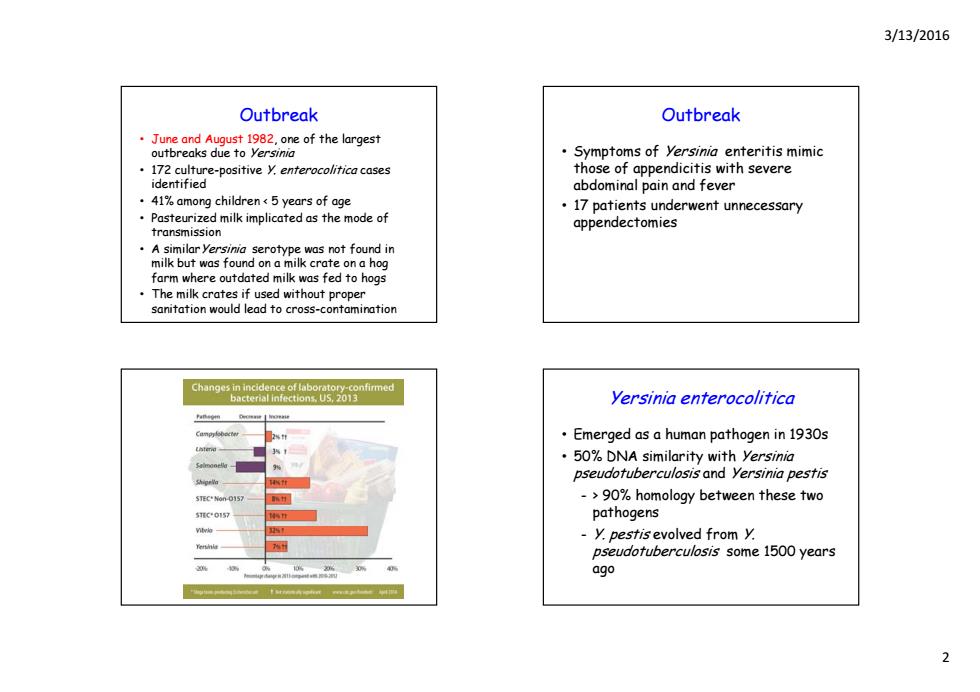
3/13/2016 Outbreak Outbreak June and August 1982,one of the largest outbreaks due to Yersinia Symptoms of yersinia enteritis mimic 172 culture-positive y.enterocolitica cases those of appendicitis with severe identified abdominal pain and fever 41%among children5 years of age 17 patients underwent unnecessary Pasteurized milk implicated as the mode of appendectomies transmission A similar yersinia serotype was not found in milk but was found on a milk crate on a hog farm where outdated milk was fed to hogs The milk crates if used without proper sanitation would lead to cross-contamination yersinia enterocolitica Emerged as a human pathogen in 1930s .50%DNA similarity with yersinia pseudotuberculosis and yersinia pestis -90%homology between these two pathogens y.pestis evolved from y. pseudotuberculosis some 1500 years ago
3/13/2016 2 Outbreak • June and August 1982, one of the largest outbreaks due to Yersinia • 172 culture-positive Y. enterocolitica cases identified • 41% among children 90% homology between these two pathogens - Y. pestis evolved from Y. pseudotuberculosis some 1500 years ago
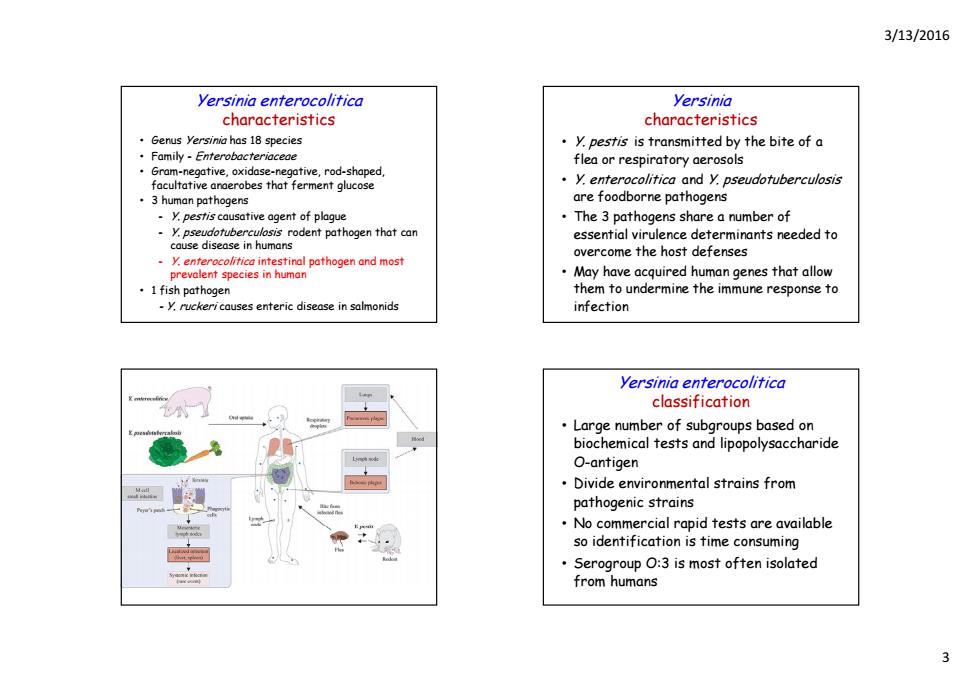
3/13/2016 yersinia enterocolitica Yersinia characteristics characteristics Genus yersinia has 18 species y.pestis is transmitted by the bite of a Family-Enterobacteriaceae Gram-negative.oxidase-negative,rod-shaped, flea or respiratory aerosols facultative anaerobes that ferment glucose y.enterocolitica and y.pseudotuberculosis ·3 human pathogens are foodborne pathogens y.pestis causative agent of plague The 3 pathogens share a number of y.pseudotuberculosis rodent pathogen that can essential virulence determinants needed to cause disease in humans 、 overcome the host defenses y.enterocolitica intestinal pathogen and most prevalent species in human May have acquired human genes that allow 1 fish pathogen them to undermine the immune response to -y.ruckericauses enteric disease in salmonids infection Yersinia enterocolitica classification Large number of subgroups based on biochemical tests and lipopolysaccharide O-antigen Divide environmental strains from pathogenic strains No commercial rapid tests are available so identification is time consuming Serogroup O:3 is most often isolated from humans
3/13/2016 3 Yersinia enterocolitica characteristics • Genus Yersinia has 18 species • Family - Enterobacteriaceae • Gram-negative, oxidase-negative, rod-shaped, facultative anaerobes that ferment glucose • 3 human pathogens - Y. pestis causative agent of plague - Y. pseudotuberculosis rodent pathogen that can cause disease in humans - Y. enterocolitica intestinal pathogen and most prevalent species in human • 1 fish pathogen - Y. ruckeri causes enteric disease in salmonids Yersinia characteristics • Y. pestis is transmitted by the bite of a flea or resp y iratory aerosols • Y. enterocolitica and Y. pseudotuberculosis are foodborne pathogens • The 3 pathogens share a number of essential virulence determinants needed to overcome the host defenses • May have acquired human genes that allow them to undermine the immune response to infection Yersinia enterocolitica classification • Large number of subgroups based on biochemical tests and lipopolysaccharide O-antigen • Divide environmental strains from pathogenic strains • No commercial rapid tests are available so identification is time consuming • Serogroup O:3 is most often isolated from humans
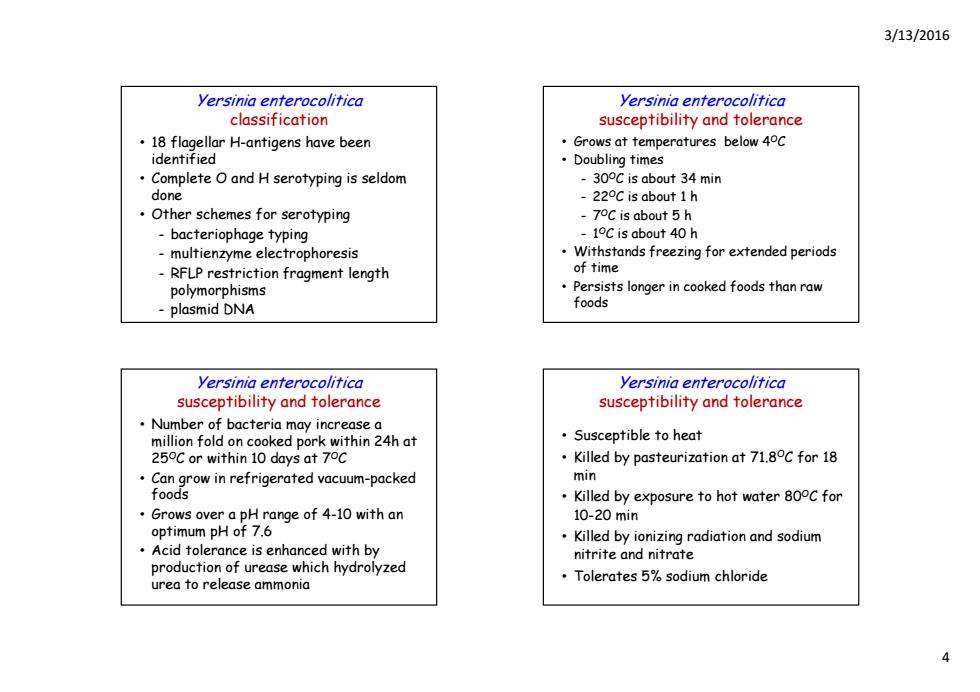
3/13/2016 yersinia enterocolitica yersinia enterocolitica classification susceptibility and tolerance 18 flagellar H-antigens have been Grows at temperatures below 40c identified ·Doubling times Complete O and H serotyping is seldom -300C is about 34 min done -220C is about 1h Other schemes for serotyping -70C is about 5 h bacteriophage typing -10C is about 40 h -multienzyme electrophoresis Withstands freezing for extended periods -RFLP restriction fragment length of time polymorphisms Persists longer in cooked foods than raw plasmid DNA foods yersinia enterocolitica Yersinia enterocolitica susceptibility and tolerance susceptibility and tolerance Number of bacteria may increase a million fold on cooked pork within 24h at ·Susceptible to heat 250C or within 10 days at 70C Killed by pasteurization at 71.80C for 18 Can grow in refrigerated vacuum-packed min foods Killed by exposure to hot water 800C for Grows over a pH range of 4-10 with an 10-20min optimum pH of 7.6 Killed by ionizing radiation and sodium Acid tolerance is enhanced with by nitrite and nitrate production of urease which hydrolyzed urea to release ammonia Tolerates 5%sodium chloride
3/13/2016 4 Yersinia enterocolitica classification • 18 flagellar H-antigens have been identified • Complete O and H serotyping is seldom done • Other schemes for serotyping - bacteriophage typing - multienzyme electrophoresis - RFLP restriction fragment length polymorphisms - plasmid DNA Yersinia enterocolitica susceptibility and tolerance • Grows at temperatures below 4 O C • D gm oublin g ti mes - 30 OC is about 34 min - 22 OC is about 1 h - 7 OC is about 5 h - 1 OC is about 40 h • Withstands freezing for extended periods of time • Persists longer in cooked foods than raw foods Yersinia enterocolitica susceptibility and tolerance • Number of bacteria may increase a million fold on cooked pork within 24h at 25 OC or within 10 days at 7 O C • Can grow in refrigerated vacuum-packed foods • Grows over a pH range of 4-10 with an opti H f 7 6 timum pH of 7.6 • Acid tolerance is enhanced with by production of urease which hydrolyzed urea to release ammonia Yersinia enterocolitica susceptibility and tolerance • Susceptible to heat • Killed by pasteurization at 71.8 OC for 18 min • Killed by exposure to hot water 80 OC for 10-20 min • Killed by ionizing radiation and sodium nitrite and nitrate • Tolerates 5% sodium chloride
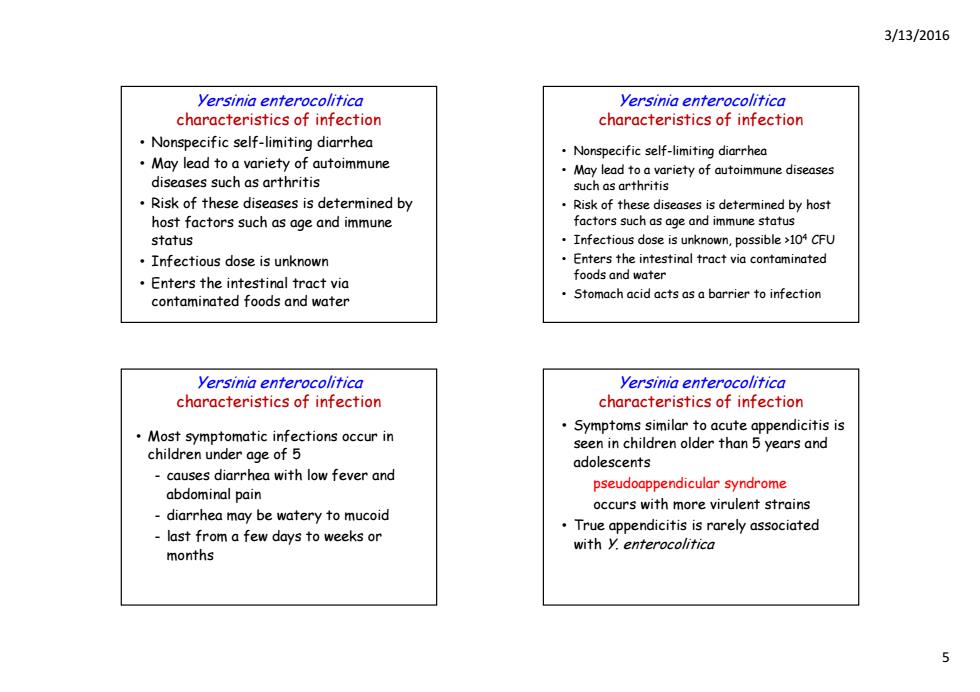
3/13/2016 yersinia enterocolitica yersinia enterocolitica characteristics of infection characteristics of infection Nonspecific self-limiting diarrhea Nonspecific self-limiting diarrhea May lead to a variety of autoimmune May lead to a variety of autoimmune diseases diseases such as arthritis such as arthritis Risk of these diseases is determined by Risk of these diseases is determined by host host factors such as age and immune factors such as age and immune status status Infectious dose is unknown,possible >104 CFU Infectious dose is unknown Enters the intestinal tract via contaminated Enters the intestinal tract via foods and water contaminated foods and water Stomach acid acts as a barrier to infection yersinia enterocolitica Yersinia enterocolitica characteristics of infection characteristics of infection Symptoms similar to acute appendicitis is Most symptomatic infections occur in seen in children older than 5 years and children under age of 5 adolescents causes diarrhea with low fever and pseudoappendicular syndrome abdominal pain occurs with more virulent strains -diarrhea may be watery to mucoid True appendicitis is rarely associated last from a few days to weeks or with y.enterocolitica months
3/13/2016 5 Yersinia enterocolitica characteristics of infection • Nonspecific self-limiting diarrhea • May lead to a variety of autoimmune diseases such as arthritis • Risk of these diseases is determined by host factors such as age and immune status • Infectious dose is unknown • Enters the intestinal tract via contaminated foods and water Yersinia enterocolitica characteristics of infection • Nonspecific self-limiting diarrhea • M l d f d May lead to a variety of autoimmune diseases such as arthritis • Risk of these diseases is determined by host factors such as age and immune status • Infectious dose is unknown, possible Infectious dose is unknown, possible 10 > 4 CFU • Enters the intestinal tract via contaminated foods and water • Stomach acid acts as a barrier to infection Yersinia enterocolitica characteristics of infection • Most symptomatic infections occur in children under age of 5 - causes diarrhea with low fever and abdominal pain - diarrhea may be watery to mucoid - last from a few days to weeks or months Yersinia enterocolitica characteristics of infection • Symptoms similar to acute appendicitis is seen in children older than 5 years and adolescents pseudoappendicular syndrome occurs with more virulent strains • True appendicitis is rarely associated with Y. enterocolitica
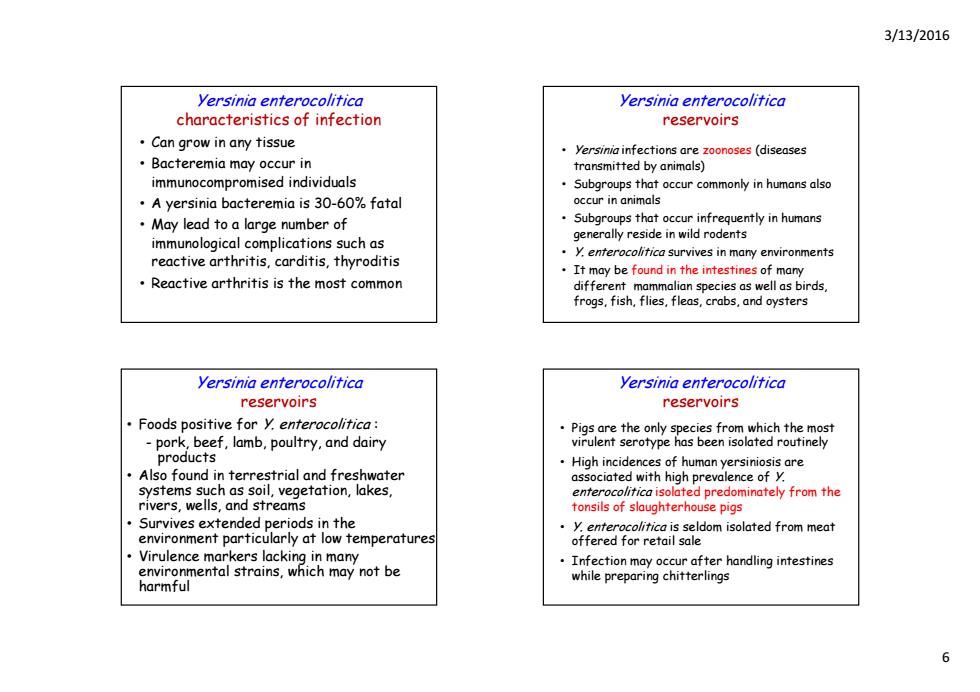
3/13/2016 yersinia enterocolitica Yersinia enterocolitica characteristics of infection reservoirs ·Can grow in any tissue Yersiniainfections are zoonoses (diseases Bacteremia may occur in transmitted by animals) immunocompromised individuals Subgroups that occur commonly in humans also A yersinia bacteremia is 30-60%fatal occur in animals May lead to a large number of Subgroups that occur infrequently in humans immunological complications such as generally reside in wild rodents reactive arthritis,carditis,thyroditis y.enterocolitica survives in many environments It may be found in the intestines of many Reactive arthritis is the most common different mammalian species as well as birds, frogs,fish,flies,fleas,crabs,and oysters Yersinia enterocolitica Yersinia enterocolitica reservoirs reservoirs Foods positive for y.enterocolitica: Pigs are the only species from which the most -pork,beef,lamb,poultry,and dairy virulent serotype has been isolated routinely products High incidences of human yersiniosis are Also found in terrestrial and freshwater associated with high prevalence of y. systems such as soil,vegetation,lakes, enterocolitica isolated predominately from the rivers,wells,and streams tonsils of slaughterhouse pigs Survives extended periods in the y.enterocolitica is seldom isolated from meat environment particularly at low temperatures offered for retail sale Virulence markers lacking in many Infection may occur after handling intestines environmental strains,which may not be while preparing chitterlings harmful 6
3/13/2016 6 Yersinia enterocolitica characteristics of infection • Can grow in any tissue • Bacteremia may occur in immunocompromised individuals • A yersinia bacteremia is 30-60% fatal • May lead to a large number of immunological complications such as reactive arthritis, carditis, thyroditis • Reactive arthritis is the most common Yersinia enterocolitica reservoirs • Yersinia infections are zoonoses (diseases transmitted by animals) • Subgroups that occur commonly in humans also occur in animals • Subgroups that occur infrequently in humans generally reside in wild rodents • Y. enterocolitica survives in many environments • It may be found in the intestines of many different mammalian species as well as birds, frogs, fish, flies, fleas, crabs, and oysters Yersinia enterocolitica reservoirs • Foods positive for Y. enterocolitica : - p , f, m , p y, y ork, beef, la m b, poultry, and dair y products • Also found in terrestrial and freshwater systems such as soil, vegetation, lakes, rivers, wells, and streams • Survives extended periods in the environment particularly at low temperatures • Virulence markers lacking in many environmental strains, which may not be harmful Yersinia enterocolitica reservoirs • Pigs are the only species from which the most virulent serotyp y e has been isolated routinel y • High incidences of human yersiniosis are associated with high prevalence of Y. enterocolitica isolated predominately from the tonsils of slaughterhouse pigs • Y enterocolitica Y. enterocolitica is seldom isolated from meat offered for retail sale • Infection may occur after handling intestines while preparing chitterlings
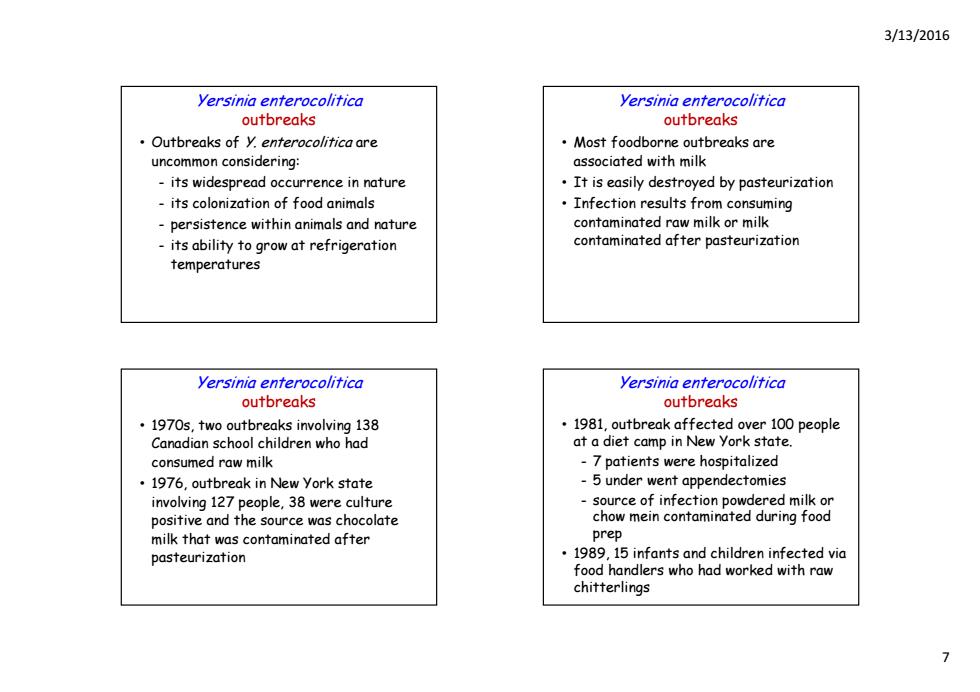
3/13/2016 yersinia enterocolitica yersinia enterocolitica outbreaks outbreaks Outbreaks of y.enterocolitica are Most foodborne outbreaks are uncommon considering: associated with milk its widespread occurrence in nature It is easily destroyed by pasteurization -its colonization of food animals Infection results from consuming -persistence within animals and nature contaminated raw milk or milk its ability to grow at refrigeration contaminated after pasteurization temperatures yersinia enterocolitica Yersinia enterocolitica outbreaks outbreaks 1970s,two outbreaks involving 138 1981.outbreak affected over 100 people Canadian school children who had at a diet camp in New york state consumed raw milk -7 patients were hospitalized 1976,outbreak in New york state -5 under went appendectomies involving 127 people,38 were culture source of infection powdered milk or positive and the source was chocolate chow mein contaminated during food milk that was contaminated after prep pasteurization 1989,15 infants and children infected via food handlers who had worked with raw chitterlings
3/13/2016 7 Yersinia enterocolitica outbreaks • Outbreaks of Y. enterocolitica are uncommon considering: - its widespread occurrence in nature - its colonization of food animals - persistence within animals and nature - its ability to grow at refrigeration temperatures Yersinia enterocolitica outbreaks • Most foodborne outbreaks are associated with milk • It is easily destroyed by pasteurization • Infection results from consuming contaminated raw milk or milk contaminated after pasteurization Yersinia enterocolitica outbreaks • 1970s, two outbreaks involving 138 Canadian school children who had consumed raw milk • 1976, outbreak in New York state involving 127 people, 38 were culture positive and the source was chocolate milk that was contaminated after pasteurization Yersinia enterocolitica outbreaks • 1981, outbreak affected over 100 people at a diet camp in New York state. - 7 patients were hospitalized - 5 under went appendectomies - source of infection powdered milk or chow mein contaminated during food prep • 1989, 15 infants and children infected via food handlers who had worked with raw chitterlings

3/13/2016 yersinia enterocolitica mechanisms of pathogenicity Invasive enteric (intestinal)pathogen Distal ileum(part of the intestines)is the main infection site ·Animal model studies show that after penetrating intestinal epithelial cells,the pathogen can spread to the lymph nodes and then to the blood yersinia enterocolitica virulence determinants Chromosomal virulence determinants Invasin:outer membrane protein encoded by the inv gene Related to intimin,an essential virulence determinant of EHEC Amino terminus is inserted into the outer membrane Carboxy terminus binds host cell integrins 8
3/13/2016 8 Yersinia enterocolitica mechanisms of pathogenicity • Invasive enteric (intestinal) pathogen • Distal ileum (part of the intestines) is the main infection site • Animal model studies show that after penetrating intestinal epithelial cells, the pathogen can spread to the lymph nodes and then to the blood Yersinia enterocolitica virulence determinants Chromosomal virulence determinants • Invasin: outer membrane protein encoded by the inv gene • Related to intimin, an essential virulence determinant of EHEC • Amino terminus is inserted into the outer membrane • Carboxy terminus binds host cell integrins Integrins

3/13/2016 yersinia enterocolitica yersinia enterocolitica virulence determinants virulence determinants Chromosomal virulence determinants Other virulence determinants Most strains secrete a heat-stable Iron overload in patients increases the risk for yersiniosis enterotoxin called yst -availability of iron in tissues Contribution of yst to diarrhea is Phospholipase A (yp/A)hydrolyzes unknown phospholipids in membranes and lyses red Ingestion of the preformed toxin in food blood cells is unlikely as the temperature required Urease increases acid tolerance to produce the toxin would result in -catalyzes release of ammonia from urea severe food spoilage contributes to survival in host tissues but the mechanism is unknown Yersinia enterocolitica virulence determinants Other virulence determinants ·pyV plasmid -highly invasive strains carry pyv -aids resistance to phagocytosis and lysis Type III secretion system -inject proteins into the host cytosol that aid pathogenicity
3/13/2016 9 Yersinia enterocolitica virulence determinants Chromosomal virulence determinants • Most strains secrete a heat-stable enterotoxin called Yst • Contribution of Yst to diarrhea is unknown • Ingestion of the preformed toxin in food is unlikely as the temperature required to produce the toxin would result in severe food spoilage Yersinia enterocolitica virulence determinants Other virulence determinants • Iron overload in patients increases the risk for yersiniosis - availability of iron in tissues • Phospholipase A (yplA) hydrolyzes phospholipids in membranes and lyses red blood cells • Urease increases acid tolerance - catalyzes release of ammonia from urea - contributes to survival in host tissues but the mechanism is unknown Yersinia enterocolitica virulence determinants Other virulence determinants • pYV plasmid - highly invasive strains carry pYV - aids resistance to phagocytosis and lysis • Type III secretion system - inject proteins into the host cytosol that aid pathogenicity
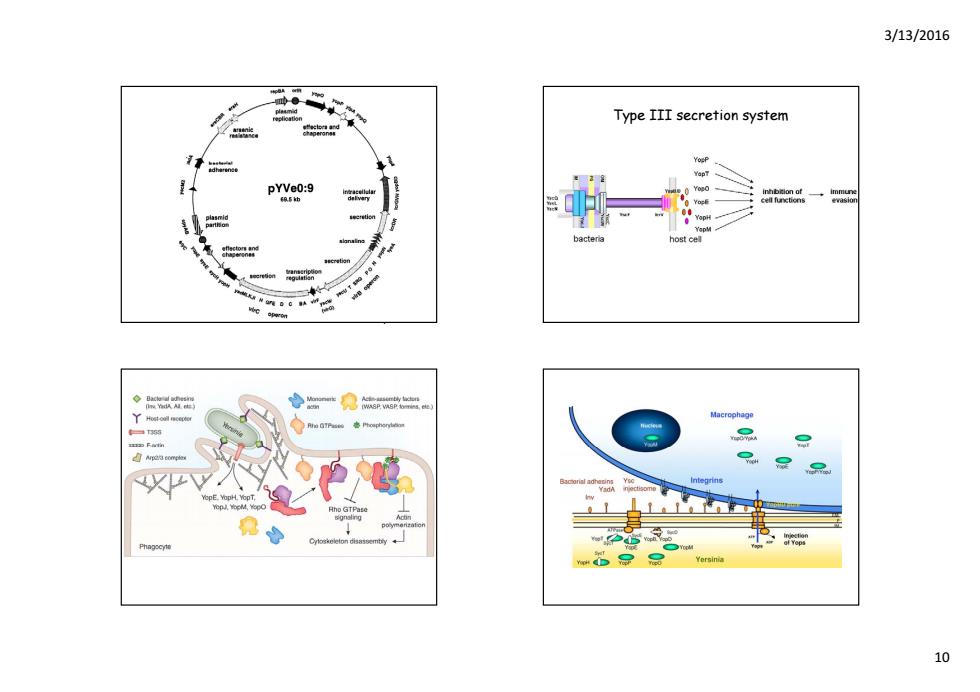
3/13/2016 Type III secretion system 4w8w 0 ophag 10
3/13/2016 10 Type III secretion system